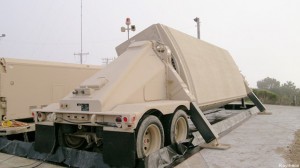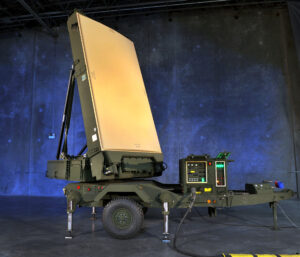Raytheon Wins MDA Gallium Nitride Radar Deal: Companies Shift To GaN
Posted on
ARLINGTON: Two recent contracts make clear the military radar industry is shifting to a new gold standard, a once-obscure material called Gallium Nitride. GaN, a high-efficiency semiconductor, makes radar transmitters much more powerful without using more electricity. Industry consultant Loren Thompson once told us it was “the biggest thing since silicon.”
Just in time for the massive Association of the US Army conference, Raytheon will announce tomorrow morning a contract with the Missile Defense Agency to retool its AN/TPY-2 production line to handle GaN. (A follow-on contract to build the radars themselves is still in the works). AN/TPY-2 is a long-range radar used by both MDA and Army THAAD missile defense units.

Raytheon AN/TPY-2 missile defense radar
Just weeks earlier, Northrop Grumman signed a deal to sell the Marine Corps its first GaN radars, upgraded models of the G/ATOR ground-based radar (AN/TPS-80). G/ATOR replaces three old Marine radars for air defense, air traffic control at forward bases, and locating enemy artillery for counter-battery fire.
These are just the latest moves in an inexorable industry-wide migration. The biggest defense contractor on the planet, Lockheed Martin, is already exporting ground-based GaN radars (AN/TPS-77s) to Romania and Latvia. Last year, Lockheed got contracts to build GaN radars for the Space Fence project tracking orbital hazards and to build a GaN Long-Range Discrimination Radar (LRDR) for the Missile Defense Agency.
As for Raytheon, besides upgrading AN/TPY-2, the company is using GaN in the Air & Missile Defense Radar (AMDR) on the future Flight III upgrade of the Navy’s Arleigh Burke destroyers. It’s also offering a GaN radar upgrade for the famous and widely exported Patriot missile defense system.
Raytheon’s GaN Patriot sets the company up to compete with Lockheed for the contract to either upgrade or replace Patriot, the Army’s Lower-Tier Air & Missile Defense (LTAMD) system. Raytheon touts itself as the only company to have its own foundry (in Andover, Mass.) that builds GaN integrated circuits, which it says is more secure than buying them on the open market as Lockheed and others do. Lockheed argues its approach lets it get the latest innovations for the lowest cost.
Why all this investment? Raytheon missile defense director Jim Bedingfield told reporters today that replacing traditional Gallium Arsenide (GaS or GaAs) with the more energy-efficient Gallium Nitride (GaN) can increase an existing radar’s range by 50 percent, improve its ability to discriminate between different kinds of targets, or increase the volume it can search five-fold. Or you can improve all three to a lesser extent — range, discrimination, and search volume — according to the customer’s needs. Or you can build an all-new radar that has the same performance but which is much smaller and uses much less electricity.

Marine Corps G/ATOR radar, built by Northrop Grumman.
Old-school Gallium Arsenide is clearly on its way out, said the Marine Corps’ program manager for G/ATOR. With the Marine radar scheduled for full-rate production in 2019, “we’re about to field a brand-new capability, you don’t want to field it with a (material) that’s going to be obsolete in ten years,” John Karlovich told me. “We would be missing an opportunity to deliver….capability that will pace the threat for years to come.”
So confident is Karlovich in GaN, he told me, that “we won’t do the full testing until we take delivery of our GaN LRIP.” That refers to the Low-Rate Initial Production radars, the first GaN-equipped batch of which just went under contract this month and will be delivered by late 2018. They’ve already tested the whole G/ATOR system with the old GaS components, he explained, and they’ve already tested the GaN transmitter/receiver modules on their own. They just haven’t put the two together yet — but Karlovich argues that replacing GaS with GaN is a simple switch that won’t produce any surprises in final testing.
“We have been sticking GaN T/R modules into our (current) GaS systems and only powering those individual modules now for several years,” Karlovich said, “so we already know the plug and play does work.”
That bet may sound a bit optimistic, given past defense programs that entered production before they finished testing. But the Pentagon and industry alike are clearly all-in on Gallium Nitride.
Subscribe to our newsletter
Promotions, new products and sales. Directly to your inbox.
